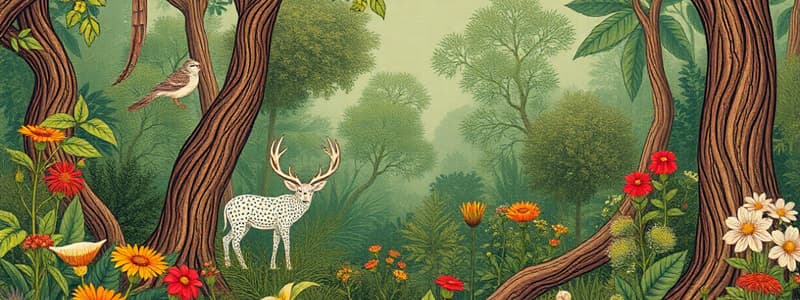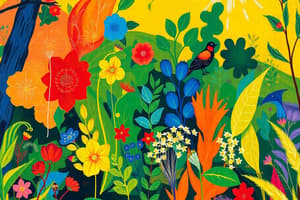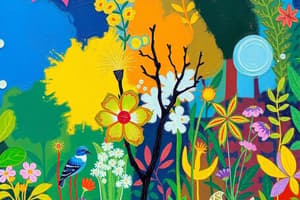Podcast
Questions and Answers
What is meant by 'virgin vegetation' in the context of natural vegetation?
What is meant by 'virgin vegetation' in the context of natural vegetation?
Virgin vegetation refers to plant communities that have grown naturally without human intervention and have remained undisturbed for a long time.
How does the diversity of plant species in India compare globally?
How does the diversity of plant species in India compare globally?
India has about 47,000 plant species, ranking tenth in the world and fourth in Asia for plant diversity.
What are the two categories of plants based on their origin in India?
What are the two categories of plants based on their origin in India?
The two categories are endemic or indigenous species, which are purely Indian, and exotic plants, which have come from outside India.
What is the difference between flora and fauna?
What is the difference between flora and fauna?
Name two types of forests mentioned that are found in India.
Name two types of forests mentioned that are found in India.
What percentage of the world's total flowering plants is represented by India's 15,000 flowering plants?
What percentage of the world's total flowering plants is represented by India's 15,000 flowering plants?
What is the ecological significance of mangrove forests?
What is the ecological significance of mangrove forests?
What is the main concern highlighted in the content regarding wildlife?
What is the main concern highlighted in the content regarding wildlife?
Identify two endangered animal species mentioned in the text.
Identify two endangered animal species mentioned in the text.
What role do insects play in the ecosystem according to the passage?
What role do insects play in the ecosystem according to the passage?
Name one step that the Indian government has taken to protect endangered species.
Name one step that the Indian government has taken to protect endangered species.
How can individuals contribute to the protection of endangered animals and birds?
How can individuals contribute to the protection of endangered animals and birds?
Which medicinal plant found only in India is commonly used to treat high blood pressure?
Which medicinal plant found only in India is commonly used to treat high blood pressure?
What is the primary use of the seed powder of Jamun?
What is the primary use of the seed powder of Jamun?
How is the fresh juice of Arjun leaves utilized in traditional medicine?
How is the fresh juice of Arjun leaves utilized in traditional medicine?
What medicinal property is associated with Neem?
What medicinal property is associated with Neem?
Which medicinal plant is specifically noted for curing cough and cold?
Which medicinal plant is specifically noted for curing cough and cold?
Name a medicinal plant used to cure asthma and digestive problems.
Name a medicinal plant used to cure asthma and digestive problems.
What is the conservation status of 52 out of the 352 medicinal plants listed by the World Conservation Union?
What is the conservation status of 52 out of the 352 medicinal plants listed by the World Conservation Union?
What plants are commonly used to treat eye sores according to traditional practices?
What plants are commonly used to treat eye sores according to traditional practices?
Identify one main habitat of elephants in India.
Identify one main habitat of elephants in India.
Which animals inhabit the swampy and marshy lands of Assam and West Bengal?
Which animals inhabit the swampy and marshy lands of Assam and West Bengal?
What unique feature distinguishes Indian wildlife in terms of large carnivores?
What unique feature distinguishes Indian wildlife in terms of large carnivores?
Which forest serves as the natural habitat for the Indian lion?
Which forest serves as the natural habitat for the Indian lion?
How many species of birds are estimated to be found in India?
How many species of birds are estimated to be found in India?
Which types of animals are found in the rivers, lakes, and coastal areas of India?
Which types of animals are found in the rivers, lakes, and coastal areas of India?
What percentage of the world's total animal species can be found in India?
What percentage of the world's total animal species can be found in India?
What legislative act was implemented in India to protect wildlife?
What legislative act was implemented in India to protect wildlife?
Which mammals are mentioned in the text as significant members of the cat family in India?
Which mammals are mentioned in the text as significant members of the cat family in India?
What is the significance of the Himalayan region concerning wildlife?
What is the significance of the Himalayan region concerning wildlife?
What role do edible plants play according to the context?
What role do edible plants play according to the context?
Name two types of deer mentioned in the text that inhabit India.
Name two types of deer mentioned in the text that inhabit India.
What distinguishes moist deciduous forests from dry deciduous forests in terms of rainfall?
What distinguishes moist deciduous forests from dry deciduous forests in terms of rainfall?
Which tree species is identified as the most dominant in tropical deciduous forests?
Which tree species is identified as the most dominant in tropical deciduous forests?
List some commercially important species found in moist deciduous forests.
List some commercially important species found in moist deciduous forests.
In which geographic areas are moist deciduous forests primarily located in India?
In which geographic areas are moist deciduous forests primarily located in India?
What is a notable feature of the vegetation structure in moist deciduous forests?
What is a notable feature of the vegetation structure in moist deciduous forests?
Identify the common animals that inhabit moist deciduous forests.
Identify the common animals that inhabit moist deciduous forests.
How does the tree shedding process differ in tropical deciduous forests compared to other forest types?
How does the tree shedding process differ in tropical deciduous forests compared to other forest types?
What types of animals can be found in dry deciduous forests, and how are their populations affected?
What types of animals can be found in dry deciduous forests, and how are their populations affected?
What types of environmental conditions are required for the growth of moist deciduous forests?
What types of environmental conditions are required for the growth of moist deciduous forests?
Flashcards
Endangered Species
Endangered Species
The state of a species being at risk of extinction.
Wildlife Reserves
Wildlife Reserves
Specific areas where plants, animals, and their habitats are protected.
Bio-reserves
Bio-reserves
Areas with rich biodiversity and unique ecosystems, protected for research and conservation.
Ecosystem
Ecosystem
Signup and view all the flashcards
Conservation
Conservation
Signup and view all the flashcards
What is Natural Vegetation?
What is Natural Vegetation?
Signup and view all the flashcards
What are endemic or indigenous species?
What are endemic or indigenous species?
Signup and view all the flashcards
What are exotic plants?
What are exotic plants?
Signup and view all the flashcards
What are Tropical Evergreen Forests?
What are Tropical Evergreen Forests?
Signup and view all the flashcards
What are Tropical Deciduous Forests?
What are Tropical Deciduous Forests?
Signup and view all the flashcards
What are Tropical Thorn Forests and Scrubs?
What are Tropical Thorn Forests and Scrubs?
Signup and view all the flashcards
What are Montane Forests?
What are Montane Forests?
Signup and view all the flashcards
Sarpagandha
Sarpagandha
Signup and view all the flashcards
Jamun
Jamun
Signup and view all the flashcards
Arjun
Arjun
Signup and view all the flashcards
Babool
Babool
Signup and view all the flashcards
Neem
Neem
Signup and view all the flashcards
Tulsi
Tulsi
Signup and view all the flashcards
Kachnar
Kachnar
Signup and view all the flashcards
Elephants
Elephants
Signup and view all the flashcards
One-horned Rhinoceros
One-horned Rhinoceros
Signup and view all the flashcards
Wild Ass
Wild Ass
Signup and view all the flashcards
Wildlife Protection Act
Wildlife Protection Act
Signup and view all the flashcards
Natural Vegetation
Natural Vegetation
Signup and view all the flashcards
Flora
Flora
Signup and view all the flashcards
Wildlife Sanctuary
Wildlife Sanctuary
Signup and view all the flashcards
Tiger
Tiger
Signup and view all the flashcards
Gharial
Gharial
Signup and view all the flashcards
Gir Forest
Gir Forest
Signup and view all the flashcards
Bio-diverse Environment
Bio-diverse Environment
Signup and view all the flashcards
Animal of Prey
Animal of Prey
Signup and view all the flashcards
Moist Deciduous Forests
Moist Deciduous Forests
Signup and view all the flashcards
Dry Deciduous Forests
Dry Deciduous Forests
Signup and view all the flashcards
Deciduous Forest
Deciduous Forest
Signup and view all the flashcards
Tropical Deciduous Forests
Tropical Deciduous Forests
Signup and view all the flashcards
Evergreen Forests
Evergreen Forests
Signup and view all the flashcards
Tropical Evergreen Forests
Tropical Evergreen Forests
Signup and view all the flashcards
Multilayered Structure
Multilayered Structure
Signup and view all the flashcards
Luxuriant Vegetation
Luxuriant Vegetation
Signup and view all the flashcards
Study Notes
Natural Vegetation and Wildlife
- India is one of 12 mega biodiversity countries globally, ranking tenth worldwide and fourth in Asia for plant diversity.
- India has about 47,000 plant species, including 15,000 flowering plant species (6% of the global total).
- The country also encompasses approximately 90,000 animal species, alongside diverse fish populations in both freshwater and marine environments.
- Natural vegetation refers to naturally occurring plant communities undisturbed by humans for a long time, a concept also referred to as virgin vegetation.
- Cultivated crops and orchards are not considered natural vegetation.
- Endemic or indigenous plant species are native to India, while exotic plants are introduced from other regions.
- Flora refers to plants of a specific region or time period, correlating to fauna for animal species.
Types of Vegetation
- Tropical Evergreen Forests: These forests are concentrated in areas of high rainfall, exceeding 200 cm annually, in the Western Ghats, Lakshadweep, Andaman & Nicobar Islands, parts of Assam, and Tamil Nadu coast. They exhibit tall trees reaching 60m or more.
- Tropical Deciduous Forests: These forests are the most extensive in India, encompassing regions with between 200 to 70cm of rainfall. They display significant variations in structure, from moist (200-100cm rainfall) to dry (100-70cm rainfall), with typical trees like teak, sal, shisham, and others prevalent.
- Tropical Thorn Forests and Scrubs: These are prominent in areas receiving less than 70 cm of rainfall, featuring thorny trees.
- Montane Forests: At higher elevations, characterized by a decrease in temperature, these forests exhibit a range of vegetation types. Wet temperate forests (1000-2000m) are dominated by evergreen broadleaf trees (oaks and chestnuts).
- Mangrove Forests: These forests thrive in coastal areas influenced by tides, where mud and silt accumulate, and are characterized by mangrove trees with roots submerged underwater.
Medicinal Plants
- India has a rich tradition of medicinal plants.
- Various species like Sarpagandha, Jamun, Arjun, Babool, Neem, Tulsi, and Kachnar are commonly used in traditional medicine for diverse medicinal utilities.
Wildlife
- India boasts a diverse array of wildlife.
- Elephants, rhinoceros, Asiatic lions, tigers, and various species of deer, monkeys, and other animals inhabit various forest and ecosystem types.
Studying That Suits You
Use AI to generate personalized quizzes and flashcards to suit your learning preferences.




